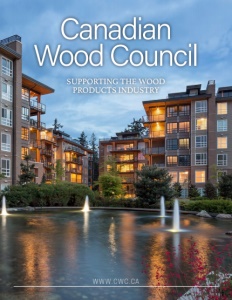Canadian Wood Council
Supporting the wood products industry
Business View Magazine interviews Kevin McKinley, President & CEO of the Canadian Wood Council, for our focus on the Wood Construction Industry in Canada
The Canadian Wood Council (CWC) represents the Canadian wood products industry through a national federation of associations. With a mission to expand market access and increase demand for Canadian wood products through excellence in codes, standards, regulations and education, the Council acts as the conduit for transferring technical knowledge to builders, architects, and engineers – all those who specify wood in construction.

President, Kevin McKinley
CWC does this by providing essential technical tools and field support needed to design with wood. This includes the development and distribution of technical manuals, web tools, design software, and a HelpDesk option. CWC also operates a pan-Canadian construction sector education program with market partners under the name of Wood WORKS!, publishing the Wood Design & Building magazine, and hosting awards programs and events. Wood WORKS! plays a very important role by working closely with the building community and governments to advance the broader use of wood in construction.
Business View Magazine recently spoke with Kevin McKinley, President & CEO of the Canadian Wood Council, about the evolution of CWC, current challenges, and how the Council will continue to promote the industry in the future. The following is an edited transcript of the conversation.
BVM: What is the background history on CWC?
McKinley: “The Canadian Wood Council was established in 1959. It really started as an association of the groups involved in the wood products industry to do some promotion and marketing and get a much-needed national approach for the industry. That evolved quickly into issues of market access. The necessity to work with the building codes and standards and regulations around construction, and to help inform and promote the use of wood construction in those areas.
“Then, 21 years ago, CWC went a bit further with its market development group and formed a special program called Wood WORKS! to bring together different marketing efforts across the country; trying to work with architects, engineers, developers, and codes officials to educate them about the opportunities of building with wood. It’s been a very successful means of outreach to the wood construction market, to the construction field.
“CWC started as a modest promotion/marketing effort, moving more into market access issues around codes and standards, then formalizing the market development aspect with WoodWORKS!. Etienne Lalonde, who led the way in the WoodWORKS! program just retired after 29 years with the Canadian Wood Council and he will be greatly missed. But he has helped us move ahead with the transition to a new revitalized team that will bring the CWC and the Wood WORKS! program to new areas.”
BVM: Are Canada’s forests managed differently from those in other countries?
McKinley: “The forest structure we have in Canada differs quite a bit from the U.S. situation, where there is a lot more private ownership. In Canada, 90 percent of our forests are on provincial or territorial Crown lands and about 84 percent of those provide the Canadian commercial timber supply. So there are a lot of tenure arrangements, which is how the governments allocate harvest rights and management responsibilities for timber on Crown land. Some arrangements are granted on specified volumes of timber and others grant access to timber resources in specific areas, so sometimes they overlap.
“It means our forests are well managed, it also means that the profile of the wood we’re getting from our forest areas in Canada is very different than that on the rest of the planet. We have the third most forested country in the world behind Russia and Brazil but 37 percent (165 million hectares) of Canadian forests are certified to third-party standards for sustainable forest management. That’s by far the highest number of hectares that follow sustainable forest practices. So it is impressive and different.”
BVM: What is your focus from a membership perspective?
McKinley: “Our members are Canada-wide, primarily lumber associations that have a very strong provincial/regional organization. Provincial associations play a big role in working with their industries that have arrangements with the governments for tenure, so CWC brings these groups together on the wood construction, design, and product development side. That’s where our focus is. We’re not involved in forestry, per se. We also have a sister association, the Forest Products Association of Canada, that deals with the resource end of things and we work very closely with them. Which means we represent the wood products industry almost completely across the country.

“Rather than tiers of membership, we have lumber and non-lumber members. Lumber tends to contribute most of the dues and membership spots on the board. Interestingly, our board of directors is made up of industry players that are nominated by the associations to fill those spots. Which is great. You’re working directly with field concerns and industry concerns and you’re supported by the associations across Canada. It’s an elegant model that works well. It was an evolution of the governance in the last couple years. And we also have advisors in different areas – architects, engineers, research – FP Innovations is a board member and a very close advisor to us. So we try to stay connected with our partners, as well.”
BVM: How are relations with U.S. counterparts in the industry?
BVM: “Outside of our CWC governance, we stay very close, operationally, with the United States. Counter to what you see in the news about softwood lumber disputes, we actually cooperate extremely well and have a great level of harmonization related to species and lumber values and acceptance of each other’s approaches for the quality infrastructure and assurance for lumber. The Canadian Wood Council cooperates on a lot of issues that the American Wood Council (AWC) does, except for lobbying. We don’t have formal government relations in our work.
“The two main streams for CWC are the codes and engineering work and the market development work. AWC’s strength is codes and engineering, and working with their government on issues is an important part of what they do, as well. Canada is also an export country, so it’s in our interest to stay very close to AWC and other groups like the APA that have a U.S.-centric approach. Our technical staff is constantly cooperating with them, making sure we don’t have unnecessary obstacles to trade.”
BVM: How does CWC promote the mass timber and wood construction industry?
McKinley: “In 2020, we targeted and exceeded 275 construction projects throughout the country being influenced, the equivalent of about 140 million board feet. So it’s been a very busy period. We do a lot of education, including online courses targeting 42,000 education hours in 2020 for engineers, architects, etc. Right now, we’re involved with over 60 tall wood building projects and about 780 mid-rise construction projects that are built or at the conceptual and design stage. Really impressive projects have included: Brock Commons at the University of British Columbia in Vancouver – that one really made a statement for mass timber. It was the first tall wood building in Vancouver and for a few years was the world’s tallest wood building. Now there’s the Arbora project in Montreal that will be the largest complex built of CLT mass timber in the world, with 434 residential units in three, eight-story buildings. At 285,000 sq. feet, Shane Homes YMCA in Calgary will be the biggest YMCA in the world. The Olympic Oval in Richmond, BC – more than six acres completely made of wood, is truly a marvel.
“We get involved in any large mass timber construction project, usually at the outset, so they have access to engineers and expertise that can help guide them in making estimating decisions or in design considerations. That is the task of CWC and WoodWORKS! – to support the Canadian wood products industry in a direct way.
“The forest industry, itself, contributes over 1 percent of Canada’s GDP and directly employs over 200,000 people, including several thousand indigenous people and immigrants. Couple that with the extensive number of wood construction projects underway, and you have a massive economic driver for Canada. Many single-family homes importantly use light-wood frame construction, and now with mass timber construction, there’s an entirely new set of design, manufacturing, and assembly skills being developed in our workforce. We have a federal government-supported “Advanced Education Roadmap” for wood construction being deployed in Canadian universities (see woodSMART.ca ). This will help provide graduate engineers and architects with needed wood design and construction to support Canada’s growing wood construction economy.
“In terms of new opportunities for the building trades, in Toronto, Local 27 of the Carpenters & Allied Workers have some exciting programs and facilities that provide new skills in the fast-emerging trend of mass timber construction. Dealing with onsite installation and assembly of prefabricated mass timber CLT and glulam, getting to know and use different types of connectors, organizing crane work, etc, are needed site skills for mass timber buildings. It’s a huge opportunity for new types of jobs supporting the future of construction in Canada.”
BVM: What does the landscape look like for the industry going forward?
McKinley: “These are challenging times, full of uncertainties. Canadians are looking for greener and more biophilic spaces for where we live and work – healthier, more open, natural and beautiful. Relative to other types of construction, wood buildings are well positioned to excel. The Canadian Wood Council is also putting a lot of emphasis on sustainability and GHG issues. We’re a key contributor to the net zero objectives of the Canadian government for 2050, as well as the U.N. sustainable development goals. We have great stories to tell and opportunities to improve even more. That’s very encouraging.”
AT A GLANCE
Canadian Wood Council
What: National organization representing the Canadian wood products industry
Where: Based in Ottawa, Ontario
Website: www.cwc.ca



